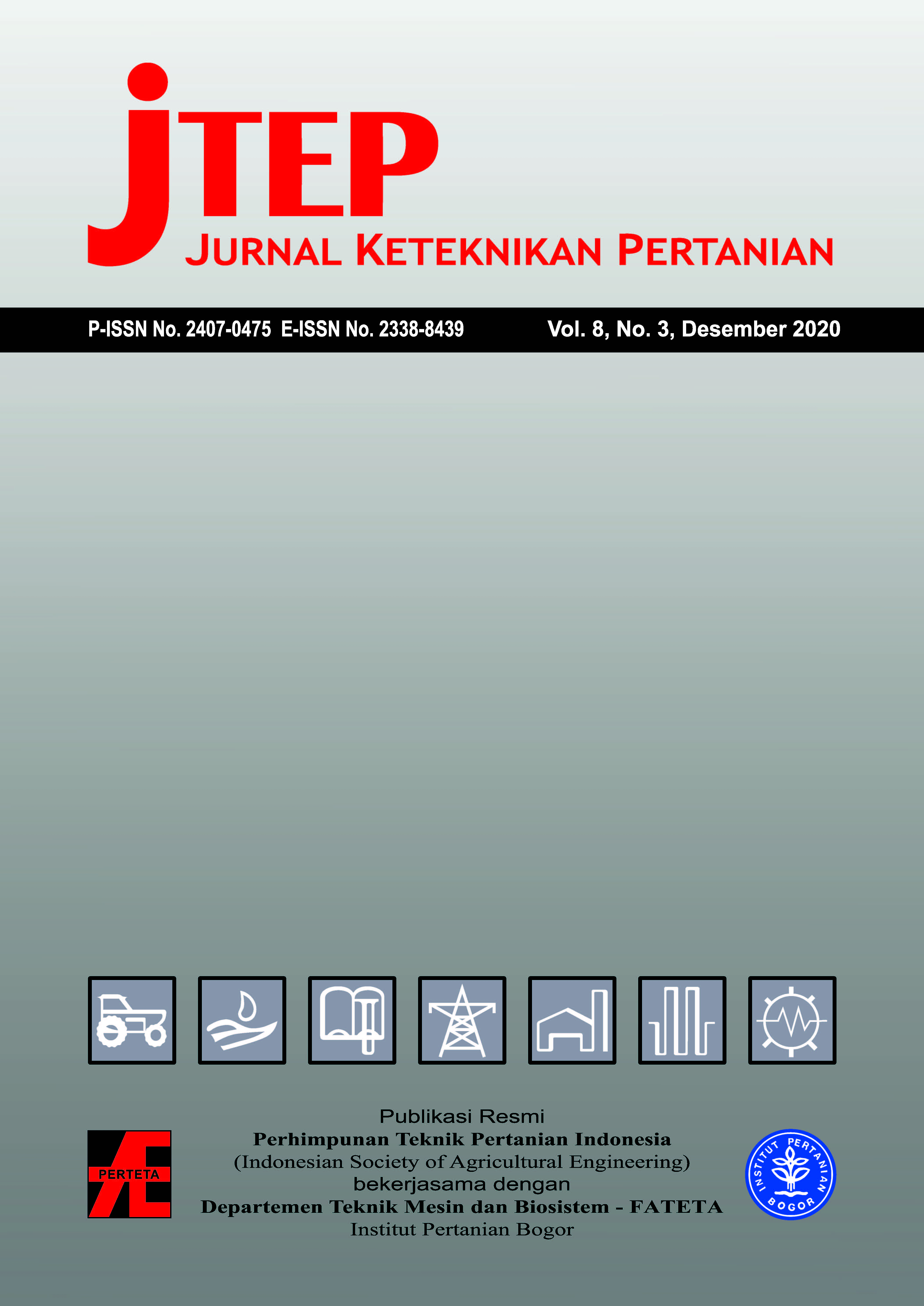Aplikasi Model Peleg untuk Analisa Rehidrasi Tekwan Kering pada Beberapa Suhu Perendaman
Abstract
This study was aimed to apply Peleg Model to analyze rehydration of dried tekwan at several variations of water immersion temperature. The method used was descriptive and experimental of one factor treatment (Non Factorial), which was immersion temperature with four treatments level (30, 45, 70 and 90oC), each treatment was done triplicate. The parameter observed was moisture content at times of observation. The result showed that the Peleg Model coefficients (K1 and K2) were inversely affected by the temperature. The relationship was expressed into non-linear regression (polynomial) with R2 value of 0,973 and 0,988. It showed that the obtained Peleg model could be applied adequately for the rehydration of dried tekwan at some immersion temperature. The resulting model also met the statistical criteria with the largest SEE and MRE values 6.73% and 3.58%. The model could predict the dried tekwan rehydration best at the temperature of 30oC and 45oC with the smallest SEE and MRE values.
References
Benseddik, A., Azzi, A., Zidoune, M.N., Khanniche, R., Besombes, C. 2018. Empirical and diffusion models of rehydration process of differently dried pumpkin slices. Journal of the Saudi Society of Agricultural Sciences, https://doi.org/10.1016/j.jssas.2018.01.003
Cunningham, S. E., McMinn, W. A. M., Magee, T. R. A. dan Richardson, P. S. 2007. Modelling Water Absorption of Pasta during Soaking. J. Food Eng., 82 : 600-607
Garcı´a-Pascual, P., Sanjua´n, N., Melis, R., Mulet, A. 2006. Morchella esculenta (morel) rehydration process modelling. Journal of Food Engineering 72: 346–353
García-Segovia, P., Andrés-Bello,A., Martínez-Monzó, J. 2011. Rehydration of air-dried Shiitake mushroom (Lentinus edodes) caps: Comparison of conventional and vacuum water immersion processes. LWT - Food Science and Technology 44 (2): 480-488
Hernando, I., Sanju´An, N., P´erez-Munuera, I, Mulet, A. 2008. Rehydration of Freeze-Dried and Convective Dried Boletusedulis Mushrooms:Effect on Some Quality Parameters. Journal of Food Science 73(8): 356-362
Karneta, R. 2013. Difusivitas Panas dan Umur Simpan Pempek Lenjer. J. Keteknikan Pertanian. 1 (1): 131-141
Markowski, M. dan Zielinska, M. 2011. Kinetics of Water Absorption and Soluble-Solid Loss of Hot air dried Carrots during Rehydration. Int. J. Food Sci. Tech. 46 : 1122-1128.
Muñoz, I., Garcia-Gil, N., Arnau, J., Gou, P. 2012. Rehydration kinetics at 5 and 15oC of dry salted meat. Journal of Food Engineering 110: 465–471
Pratama, F., Yuliati, K., dan Oktarina, I. 2004. Tekwan Kering Cepat Saji dan Metode Pembuatannya dengan Aplikasi Pembekuan. Nomor Paten : P00200300567.Universitas Sriwijaya. Palembang.
Rafiq, A., Juri Chowdhary, J., Hazarika, M.K., Makroo, H.A. 2015. Temperature dependence on hydration kinetic model parameters during rehydration of parboiled rice. J Food Sci Technol 52(9):6090–6094, doi: 10.1007/s13197-015-1790-7
Sabrina, C., Gupta, S, Abu-Ghannam, N. 2012. Effect of different rehydration temperatures on the moisture, content of phenolic compounds, antioxidant capacity and textural properties of edible Irish brown seaweed. LWT - Food Science and Technology 47: 300-307
Shafaei, S.M., Masoumi A.A., Roshan, H. 2016. Analysis of water absorption of bean and chickpea during soaking using Peleg model. Journal of the Saudi Society of Agricultural Sciences 15: 135–144
Sharanagat, V. S. , Kansal, V., Kumar, K. 2018. Modeling the effect of temperature on the hydration kinetic whole moong grain. Journal of the Saudi Society of Agricultural Sciences Vol 17: 268–274
Solomon, W. K. 2007. Hydration kinetics of lupin (lupinus albus) seeds. J. Food Process and Engineering. 30 : 119-130.
Vergeldt, F.J, Van Dalen, G., Duijster, A.J., Voda, A., Khalloufi, S., Van Vliet, L.J., Van As H., Van Duynhoven, J.P.M, Van der Sman R.G.M. 2014. Rehydration kinetics of freeze-dried carrots. Innovative Food Science and Emerging Technologies, http://dx.doi.org/10.1016/j.ifset.2013.12.002
Witrowa-Rajchert, D., dan Lewicki, P.P. 2006. Rehydration properties of dried plant tissues. J. Science and Technology. 41 : 1040-1046.
Authors

This work is licensed under a Creative Commons Attribution 4.0 International License.
Authors submitting manuscripts should understand and agree that copyright of manuscripts of the article shall be assigned/transferred to Jurnal Keteknikan Pertanian. This work is licensed under a Creative Commons Attribution-ShareAlike 4.0 International License (CC BY-SA) where Authors and Readers can copy and redistribute the material in any medium or format, as well as remix, transform, and build upon the material for any purpose, but they must give appropriate credit (cite to the article or content), provide a link to the license, and indicate if changes were made. If you remix, transform, or build upon the material, you must distribute your contributions under the same license as the original.

